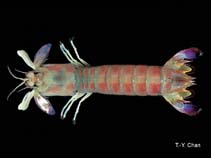Odontodactylus cultrifer (White, 1850)
Pastel odontodactylid mantis shrimpWarning: DOMDocument::load(http://sealifebase.nrm.se/webservice/AquaMaps/getAMap.php?genus=Odontodactylus&species=cultrifer): failed to open stream: HTTP request failed! in C:\Apache24\htdocs\includes\SpeciesSummary.lib.php on line 1236
Warning: DOMDocument::load(): I/O warning : failed to load external entity "http://sealifebase.nrm.se/webservice/AquaMaps/getAMap.php?genus=Odontodactylus&species=cultrifer" in C:\Apache24\htdocs\includes\SpeciesSummary.lib.php on line 1236
Classification / Names Common names | Synonyms | CoL | ITIS | WoRMS
Malacostraca | Stomatopoda | Odontodactylidae
Environment: milieu / climate zone / depth range / distribution range Ecology
Benthic; depth range 0 - 100 m (Ref. 99185). Tropical
Distribution Countries | FAO areas | Ecosystems | Occurrences | Introductions
Indo-West Pacific.
Length at first maturity / Size / Weight / Age
Maturity: Lm ? range ? - ? cm Max length : 12.5 cm TL male/unsexed; (Ref. 3160)
Short description Morphology
Pastels, with pink or purple uropods and antennal scales.
Taken together with lysiosquilids and squilids in trawling operations and at night with lights (Ref. 92). Burrows in level bottoms near shore (Ref. 92) with sandy mud substrates (Ref. 3099).
Life cycle and mating behavior Maturity | Reproduction | Spawning | Eggs | Fecundity | Larvae
Some members of the order Stomatopoda pair for life and some come together only to mate. Males produce sperm ducts rather than spermatophores; females can brood a maximum of 50,000 eggs. Life cycle: Eggs hatch to a planktonic zoea which lasts for 3 months.
Main reference
References | Coordinator | Collaborators
Manning, R.B. 1998. (Ref. 92)
IUCN Red List Status (Ref. 130435)
CITES status (Ref. 108899)
Not Evaluated
CMS (Ref. 116361)
Not Evaluated
Threat to humans
Harmless
Human uses
| FishSource |
Tools
More information
Internet sources
BHL | BOLD Systems | CISTI | DiscoverLife | FAO(Publication : search) | Fishipedia | GenBank (genome, nucleotide) | GloBI | Gomexsi | Google Books | Google Scholar | Google | PubMed | Tree of Life | Wikipedia (Go, Search) | Zoological Record
Estimates based on models
Preferred temperature
(Ref. 115969): 24.5 - 29, mean 28 (based on 1420 cells).
Price category
(Ref. 80766):
Unknown.



